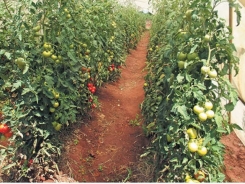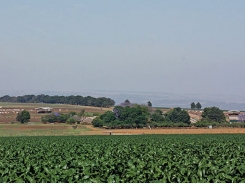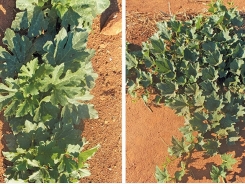Understanding genetic chimera in a crop

Farmers often draw my attention to ‘weird signs’ on a plant, fearing them to be the start of a devastating virus. A closer examination often reveals the cause to be genetic chimera, a harmless mutation that is likely to restrict growth only on the affected plant.
Genetic chimera affecting half of a cabbage plant. Were it to manifest on the entire plant, it could easily be mistaken for a virus. Photo: Bill Kerr
Cells that mutate are fairly common in both plants and animals. In some cases, scientists induce such mutations by radiation or by a chemical process in order to develop a specific quality that might benefit the affected organism.
Lack of chlorophyll and poor growth
A genetic chimera is easy to spot in ornamental plants, where it causes colourful, variegated patterns on the leaves. Of course, this is a benefit only for ornamental purposes.
These blotches mean that not all areas of the leaf produce chlorophyll, so plant growth is sub-optimal. In extreme cases, the entire plant can be white, and will die as a seedling.
The mutation occurs in the meristem, the cell tissue found in zones of the plant where growth takes place. It can affect the first, second or third layer of cells, and the symptoms will vary accordingly. It can affect the entire plant or just a section.
I first saw genetic chimera at work when my father planted a land to thornless youngberries. We propagated the shrubs by layering the canes or making cuttings.
However, I noted that when a root was disturbed at ground level, the plant would behave in the same way as its wild bramble ancestor did and send out a shoot full of thorns.
Thornless blackberries with thorns? This puzzled me as a youngster, because I did not understand the process of genetic chimera.
As I later discovered, a genetic chimera affects plant growth only above the site of mutation; the thorns emerged below that. You can use this knowledge to propagate truly thornless progeny.
Mutations can occur at any time, and if you have permanent crops, you should be on the lookout for signs of change; these might be advantageous. A fruit tree, for example, might produce fruit that is larger or has a better colour than other fruit in the orchard.
Higher profits
It is worth your while to ask pickers to report such occurrences. You could even offer a reward for anyone who spots a ‘beneficial difference’.
If you are a fruit farmer, you would certainly benefit from finding a branch that matures two weeks earlier, for example; it would enable you to obtain a far higher price for your produce on the market.
Bill Kerr is a vegetable specialist and a breeder of a range of vegetables.
Có thể bạn quan tâm
Phần mềm

Phối trộn thức ăn chăn nuôi

Pha dung dịch thủy canh

Định mức cho tôm ăn

Phối trộn phân bón NPK

Xác định tỷ lệ tôm sống

Chuyển đổi đơn vị phân bón

Xác định công suất sục khí

Chuyển đổi đơn vị tôm

Tính diện tích nhà kính

Tính thể tích ao hồ




 The amazing cactus pear
The amazing cactus pear  Learning about cucurbits
Learning about cucurbits